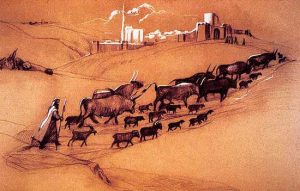Shmini Atzeres 2020 – Dead Bulls Walking
by devadmin | October 8, 2020 7:01 pm
Dead Bulls Walking:
The bad news: The Governor of the State of New York has his mind set on closing down a good number of Jewish neighborhoods, to include parts of the Five Towns, Lawrence too -most of it- and other areas for Simchas Toirah. Why? Corona! The good news: he’s not sending us to nursing homes for the last days of Yom Tov; not yet anyway. Geloibt der Abishter (thank the RBSO)!
 Why he has his eyes only on religious neighborhoods is avada a hot topic with people on both sides of the corona issue weighing in with strong opinions. To those who don’t share his views, his actions amount to a load of bullkaka. As an aside, bullkaka is a real word which according to the Urban Dictionary has several definitions. The bottom line: Bullkaka = BS! Another very vichtig: bottom line: let’s take it up a few notches and stay safe.
Why he has his eyes only on religious neighborhoods is avada a hot topic with people on both sides of the corona issue weighing in with strong opinions. To those who don’t share his views, his actions amount to a load of bullkaka. As an aside, bullkaka is a real word which according to the Urban Dictionary has several definitions. The bottom line: Bullkaka = BS! Another very vichtig: bottom line: let’s take it up a few notches and stay safe.
 Speaking of bulls, it so happens that most of you never paid attention to a ceremony which –over two thousand years back- took place daily during Sukkis, to include Shmini Atzeres, which we will be celebrating -somehow- this coming shabbis. We speak of bull offerings, many of them. What the hec are bull offerings? How many bulls were involved? Who offered them? For how much? Who got them?
Speaking of bulls, it so happens that most of you never paid attention to a ceremony which –over two thousand years back- took place daily during Sukkis, to include Shmini Atzeres, which we will be celebrating -somehow- this coming shabbis. We speak of bull offerings, many of them. What the hec are bull offerings? How many bulls were involved? Who offered them? For how much? Who got them?
Shoin, in the spirit of Hoishana Rabbah- to be celebrated tomorrow, a day when -according to some- one has a last minute opportunity to repent for committed sins, the heylige Ois has an admission to make: though he has been davening for many decades and though the siddur contains all the language one needs in order to know just how many bulls were involved, and just what took place, the emes is that he never once -until these words are being typed- paid attention to them. Yikes! He found the language boring and repetitive. He felt disconnected. Moreover, the bulls and other animals offered each day of Sukkis are also found in the heylige Toirah and those too, he never stopped and studied. The bottom line: by the time the RBSO gets around to asking why I didn’t know much about the bulls; I will know with a degree of certainty that the questioning is coming to an end. One more bottom line: I guess that most Oisvorfer readers are not much different. Nuch a zach (one more thing): before we delve a bit further into animal sacrifice talk, the Ois also makes this admission: it’s taka very challenging for the modern mind to relate to slaughtering bulls, rams, and sheep to celebrate a Yom Tov. That was then, two thousand years back. Are korbonis coming back? Ver veyst? Ober, stick with the topic for a page or so and see how our sages of yore used their creativity and imagination to connect bulls to seemingly unrelated matters.
Let’s begin by reviewing a few pisukim from the heylige Toirah where in Bamidbar29:12, we read azoy: “On the 15th day of the 7th month, there shall be a holy day for you; you shall not work; you shall make a festival for Hashem for a 7 day period.” So far so good, it’s Sukkis. If you’re reading this week’s posting, the RBSO has allowed you -despite your egregious behavior this past year (and in others)- to slip by Rosh Hashono, Yom Kippur, and even Hoishana Rabbah; He has given you a pass. Don’t’ worry, be happy and celebrate life. And taka raboyseyee, many an exegete tells us just that; we’re happy on Sukkis; because we’re alive and well post judgment!
Ober here come the next instructions. “You shall sacrifice…13 young bulls, 2 rams and 14 male lambs in their 1st year; they shall be unblemished.” The heylige Toirah then fills in a few blanks. The details are amazing. So happens that we read parts of these instructions daily -over Sukkis- during the Musif davening. As well, we read the exact instructions-again, parts of them- from the heylige Toirah each day of the Yom tov. The bottom line: the daily animal sacrifice instructions are given more space in the heylige Toirah than the actual celebratory instructions for the joyous Yom Tov of Sukkis. Seemingly, they were important to the RBSO and you too should then read the next few paragraphs. Let’s take a quick look at the chart below which delineates -with specificity mamish- the animals sacrificed daily over Sukkis.
Day 1 Day 2 Day 3 Day 4 Day 5 Day 6 Day 7
13 bulls 12 bulls 11 bulls 10 bulls 9 bulls 8 bulls 7 bulls
2 rams 2 rams 2 rams 2 rams 2 rams 2 rams 2 rams
14 lambs 14 lambs 14 lambs 14 lambs 14 lambs 14 lambs 14 lambs
1 goat 1 goat 1 goat 1 goat 1 goat 1 goat 1 goat
Shoin, with some simple instant math, you can see that 70 bulls were sacrificed over the seven days. Let’s not forget to shout out the one lone bull who gave up its life on Shmini Atzeres. How many bulls were sacrificed over the Yom Tov of Sukkis? Says the heylige Toirah in Parshas Pinchas (Bamidbar 29: 12-34), azoy: over Sukkis, a total of 70 bulls were offered as sacrifices (all as burnt offerings), spread out over the seven-day pilgrimage festival. In addition to the bull offerings, 14 lambs, 2 rams and 1 goat were also sacrificed daily. Shoin! And what stands out? Why were so many bulls involved? Why did the number go down by one bull daily? Why were the numbers steady for the lambs and other animals sacrificed? And it’s taka emes: the huge number of offerings is striking, especially when compared to sacrificial offerings on other Yom Tovs. As an aside, there is no Yom Tov -aside from Sukkis- where more than two bulls were to be sacrificed in any one given day. What’s taka pshat? Why -davka on Sukkis were the Yiddin instructed to sacrifice a total of 70 bills? And why as many as 13 on day one and then one less each day forward? Notice as well, that each day but 2 rams were offered, and take note as well that 14 lambs were offered daily but the number stayed steady. Is there some rationale for the descending order? Is there significance to the total of seventy bulls over Yom Tov?
Shoin, let’s find a few answers. Why a few? Because raboyseyee, avada you know there isn’t one topic in the entire heylige Toirah that was not hotly debated and bull offerings are no different. As an aside, when it comes to bull in general, many have an opinion. In any event, no answers are provided and no questions asked about the 14 lambs, 2 rams and 1 goat? Why not? Perhaps because the numbers were consistent. Ober questions -as posed above- are zicher asked about the bulls. Shoin! Says the heylige Gemora (Sukkah 55b)- over the Yom Tov ofSukkis, the Yiddin -in Temple times- sacrificed rams, sheep and bulls.While the number of rams and sheep sacrificed on each of Sukkis’ seven days remained constant (2 rams, 14 sheep), the bulls were offered in varying quantities. Specifically, 13 bulls were sacrificed on day one, 12 on the second day, 11 on the third day, and so on. Over seven days, 70 bulls were sacrificed. Moreover, on Shemini Atzeres, one bull lost its life. Why taka were many more bulls sacrificed over Sukkis than on Pesach? Ver veyst? Nu, of course our sages of yore were not going to let the disparity slip by without commentary, and in this shortened posting, we will share their thoughts. Never prone to glossing over details, the heylige Gemora noticed that the strangely decreasing number of bulls added up to a total of 70, or the equivalent, in rabbinic parlance, to the number of umoisho’oilom (gentile nations) on earth. OMG: if there were 70 bulls and 70 nations, shoin, they must be related. Ober is that emes? And if emes, how are these two disparate 70 numbers related?
Nu, mistama you have a few more questions to ask, and let us than begin with a direct quote from the heylige Gemora which tells us azoy: Rabbi Eleazar said: Seventy bulls for the seventy nations. But why a single bull? For the unique nation. This can be compared to a king of flesh and blood who said to his servants, “Make me a great feast.” On the last day he said to his beloved, “Make me a little feast, that I may take pleasure in you.” Rabbi Yoichonon said: Woe to those nations who sustained a loss, yet know not what they lost; for when the Temple still stood, it used to atone for them, and now who will atone for them? Shoin, now you know? I didn’t think so, ober don’t feel bad, neither do most reading those words.
Shoin, let’s try this shtikel from the heylige Toirah which in Bamidbar (29:12-34), reveals azoy: Every day one bull less was sacrificed. Says Rashi, azoy: “the bullocks offered on the Feast of Tabernacles (Sukkis) are seventy in all, an allusion to the seventy nations of the world. They gradually decrease [in number each day], an omen to them [of gradual] annihilation, but during the period when the Temple existed [and these sacrifices were offered] they – the bull offerings- protected them against this misfortune.” What? The bulls did what?
 Let’s try that again: Says Rashi that over Sukkis (the first seven days), when the Beis Hamikdash was operative, the Yiddin sacrificed a total of 70 bulls with each being an illusion to the 70 nations of the world. Pshat being that just as the bull offerings were reduced daily in number until we get to one lone bull offering on Shimini Atzeres, so too, eventually all the 70 nations would cease to exist. So far so good until we read -also from Rashi- these words: while the Beis Hamikdash stood, the sacrifice of the bulls is davka what protected the 70 nations form extinction. Which is it? The bulls represented their eventual extinction? Or, farkert, the bull offerings protected the umoisho’oilom (the other nations of goyim)? And the answer? Ver Veyst? One thing iz zicher and quite clear: these two concepts – that the 70 bulls of Sukkis represent the diminution and downfall of the 70 nations, and that the 70 bulls also protect the 70 nations – appear to be quite contradictory. Do the 70 bulls symbolize punishment or protection? How can they symbolize both? Furthermore, what does the downfall or protection of the 70 nations have to do with Sukkis? Grada, years back a gastroenterologist told me that fiber taka works both ways. It helps those stuck and those on the run. Shoin, if fiber can work its magic, why can’t 70 bulls represent both gloom and protection? Veyter.
Let’s try that again: Says Rashi that over Sukkis (the first seven days), when the Beis Hamikdash was operative, the Yiddin sacrificed a total of 70 bulls with each being an illusion to the 70 nations of the world. Pshat being that just as the bull offerings were reduced daily in number until we get to one lone bull offering on Shimini Atzeres, so too, eventually all the 70 nations would cease to exist. So far so good until we read -also from Rashi- these words: while the Beis Hamikdash stood, the sacrifice of the bulls is davka what protected the 70 nations form extinction. Which is it? The bulls represented their eventual extinction? Or, farkert, the bull offerings protected the umoisho’oilom (the other nations of goyim)? And the answer? Ver Veyst? One thing iz zicher and quite clear: these two concepts – that the 70 bulls of Sukkis represent the diminution and downfall of the 70 nations, and that the 70 bulls also protect the 70 nations – appear to be quite contradictory. Do the 70 bulls symbolize punishment or protection? How can they symbolize both? Furthermore, what does the downfall or protection of the 70 nations have to do with Sukkis? Grada, years back a gastroenterologist told me that fiber taka works both ways. It helps those stuck and those on the run. Shoin, if fiber can work its magic, why can’t 70 bulls represent both gloom and protection? Veyter.
What 70 nations? Who are they and where did they come from? Rashi just told us that the 70 oxen corresponded to the original 70 nations of the world enumerated in the heylige Toirah who all descended from the sons of Noiach, and are the ancestors of all of the nations ad hayoim hazeh (till this day). Seemingly, the Yiddin –based on Rashi- brought these 70 sacrifices over Sukkis as atonement for the nations of the world. They prayed for their well-being, as well as for universal peace and harmony between them. Exactly what that means, ver veyst? Gishmak!
Says the medrish (Bamidbar Rabba 1) azoy: Thus our Sages taught, “You find that during the Chag of Sukkis, the Yiddin offered 70 oxen for the 70 nations. Israel says: Master of the Universe, behold we offer You 70 oxen in their behalf, and they should have loved us. Instead, in the place of my love, they hate me (Tihilim109).” Further, they remarked: “If the nations of the world would have known the value of the Beis Hamikdash for them, they would have surrounded it with a fortress in order to protect it. For it was of greater value to them than for the Yiddin [instead], they destroyed it.” Seemingly it’s up to us Yiddin to also have the goyim in mind; gishmak!
The RBSO appointed the Yiddin to atone for all these nations, and appointed Yirusholayim a house of prayer for all the peoples. Therefore, when the Yiddin came to sacrifice 70 oxen during the seven days of Sukkis as an atonement for the 70 nations of the world, they sacrificed 35 oxen in behalf of the nations under Yishmoale’s dominion, and 35 in behalf of those under Eisav’s dominion. Mistama you want to know how it came to be that Yishmoale and Eisav came to split dominion over the 70 nations of the world, ober that for another day.
Says Pesikta de Rav Kahana (par. 30, be-yom shemini atzeres) says: “All seventy bulls that Israel used to sacrifice on the festival were for the seventy nations of the world, so that they not be removed from the world, as it is said: ‘They answer my love with accusation, but I am all prayer’ (Tihilim 109:4). That is, now they are protected by prayer instead of sacrifice.” According to Rashi and Rabbi Yoichonon, the gentiles were granted the RBSO’s blessing by virtue of the sacrifices, but now they are doomed to annihilation. According to Pesikta de Rav Kahana, however, they do not disappear from the world. Which is it? Ver veyst?
Let’s try one more confusing pshat. Says the Kli Yokor: that the bulls represent the physical component of man. The number seventy represents the average length of a man’s years (Tihilim90). From the time a person is born, the time his physical being has on this earth gradually decreases, until he dies and is no more. This is the point of the decreasing bull sacrifices offered on Sukkis.
The bottom line: exactly what the descending bull offerings and the total of 70 represent, ver veyst? Pick any pshat that talks to you. The Oisvorfer is left wondering azoy: how is it that among the millions of Toirah-inspired entrepreneurs all over the world, that not one has created sukkah posters depicting scenes of the 70 bulls and other animal sacrifices over Sukkis? The RBSO dedicated a good number of pisukim them; why am I still looking at rebbe posters in my sukkah? Are they mentioned in the heylige Toirah? Not! Bulls are! One can mamish envision the parading of the bulls and other animals on their way to the altar. Have the Oisvorfer identified a yet to be exploited Toirah-inspired business opportunity?
Wishing you all a continued safe Yom Tov and a gittin Shabbis koidesh.
The Heylige Oisvorfer Ruv
Yitz Grossman
Source URL: https://oisvorfer.com/shmini-atzeres-2020-dead-bulls-walking/
